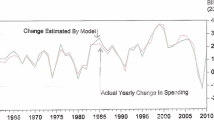Abstract
The results in this paper, using a structural multicountry macroeconometric model, suggest that there is at most a small gain from fiscal stimulus in the form of increased transfer payments or increased tax deductions if the increased debt generated must eventually be paid back. The gain in output and employment on the way up is roughly offset by the loss in output and employment on the way down as the debt from the initial stimulus is paid off. This conclusion is robust to different assumptions about monetary policy. To the extent that there is a gain, the longer one waits to begin paying the debt back the better. Possible caveats regarding the model used are that (1) monetary policy is not powerful enough to keep the economy at full employment, (2) potential output is taken to be exogenous, (3) possible permanent effects on asset prices and animal spirits from a stimulus are not taken into account, and (4) the model does not have the feature that in really bad times the economy might collapse without a stimulus.
Similar content being viewed by others
Notes
Barro and Redlick [2011] also estimate a tax multiplier.
Users can work with the MC model online or can download the model and related software to work with it on their own computer. If the model is downloaded, it can be modified and reestimated. Many of the results in MM can be duplicated online.
For countries other than the United States data were not available as late as 2013:Q3, and the overall forecast began earlier than 2013:Q4, with actual values used for the United States until 2013:Q4.
As will be seen, the MC model cycles somewhat, including values of the debt/GDP ratio, and the stopping value of λ was taken to be the first time the debt/GDP ratio came within 0.0005 of its baseline value (0.05 percentage points).
References
Auerbach, Alan J. and Yuriy Gorodnichenko . 2012. “Measuring the Output Responses to Fiscal Policy.” American Economic Review: Economic Policy, 4 (2): 1–27.
Barro, Robert J. and Charles J. Redlick . 2011. “Macroeconomic Effects from Government Purchases and Taxes.” Quarterly Journal of Economics, 126 (1): 51–102.
Bloom, Nicholas . 2009. “The Impact of Uncertainty Shocks.” Econometrica, 77 (3): 623–685.
Coenen, Günter, Christopher J. Erceg, Charles Freedman, Davide Furceri, Michael Kumhof, René Lalonde, Douglas Laxton, Jesper Lindé, Annabelle Mourougane, Dirk Muir, Susana Mursula, Carlos de Resende, John Roberts, Werner Roeger, Stephen Snudden, Mathias Trabandt and Jan in’t Veld . 2012. “Effects of Fiscal Stimulus in Structural Models.” American Economic Journal: Macroeconomics, 4 (1): 22–68.
Congressional Budget Office, 2010. Estimated Impact of the American Recovery and Reinvestment Act on Employment and Economic Output From October 2009 through December 2009. February.
DeLong, J. Bradford and Lawrence H. Summers . 2012. Fiscal Policy in a Depressed Economy. Brookings Papers on Economic Activity, Spring 233–274.
Fair, Ray C. 2010. “Estimated Macroeconomic Effects of the U.S. Stimulus Bill.” Contemporary Economic Policy, 28 (4): 439–452.
Hall, Robert E. 2009. “By How Much Does GDP Rise if the Government Buys More Output?” Brookings Papers on Economic Activity, Fall: 183–231.
Ramey, Valerie A. 2011. “Can Government Purchases Stimulate the Economy?” Journal of Economic Literature, 49 (3): 673–685.
Romer, Christina D. and Jared Bernstein . 2009. The Job Impact of the American Recovery and Reinvestment Plan. Council of Economic Advisers, January 10.
Romer, Christina D. and David H. Romer . 2010. “The Macroeconomic Effects of Tax Changes: Estimates Based on a New Measure of Fiscal Shocks.” American Economic Review, 100 (3): 763–801.
Tinbergen, Jan . 1939. Statistical Testing of Business-Cycle Theories, Volume 2, Business Cycles in the United States of America, 1919–1932. League of Nations.
Acknowledgements
I am indebted to William Brainard for helpful discussions.
Additional information
*Ray C. Fair is a professor of economics at Yale University, where he has been since 1974. His main research is in macroeconometrics, but he has also done work in the areas of finance, voting behavior, and aging in sports. He is a 1964 graduate of Fresno State College and received his Ph.D. from MIT in 1968. The MC model used in this paper can be accessed on his website: http://fairmodel.econ.yale.edu.
Rights and permissions
About this article
Cite this article
Fair, R. Is Fiscal Stimulus a Good Idea?. Bus Econ 49, 244–252 (2014). https://doi.org/10.1057/be.2014.27
Published:
Issue Date:
DOI: https://doi.org/10.1057/be.2014.27




